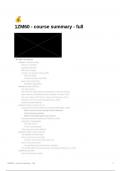1ZM60 - course summary - full
Table of contents
Lecture 1: overview selling
Selling vs marketing
Economic relevance
B2B vs B2C buying
Complex new products (Thull, 2003)
Personal selling
Decision-Making Units (DMU)
Buyer-seller relationship
Information asymmetry
Lecture 2: sales & NPD (!)
The sales process
Inter and intra-organizational characteristics of the sales process
Value-creation of salespeople (Haas, Snehota & Corsaro, 2011)
The role of sales in NPD (Ernst, Hoyer and Rübsaamen, 2011)
Changes in the role of sales (Homburg et al., 2015)
Customer-product dilemma
Lecture 3: sales & market entry (!)
Success factors for launching new products (DiBenedetto, 1999)
Skills, resources, and strategic launch activities
Tactical launch activities
Market information-gathering activities
Preannouncement (Schatzel and Calantone, 2006)
Daily tasks of salespeople
The sales funnel
Prevent overproduction
Influencing new product diffusion
Lecture 4: sales & social media (!)
The definition of social media
When to (not) use social media
Customer status and buying center size
How to use social media?
Thought leadership and influencer marketing
The optimal B2B social media post for new products (Swani et al., 2016)
Lecture 5: post-sales
Types of (expansion) selling
1ZM60 - course summary - full 1
, Servitization (Vandermerwe and Rada, 1988):
Product-Service Systems (Beuren, Ferreira, and Miguel, 2013)
After-sales services (i.e., industrial services)
When to continue selling “after the deal”
Proactive Post-Sales (PPS)
Reactive (RPS) vs proactive post-sales
Lecture 6: sales forecasting
Why forecasting?
Causes of poor forecasts
Top-down vs bottom-up forecasting
Aggregation levels
Qualitative forecasting techniques
Product testing and test markets (Fisher and Rajaram, 2000)
Quantitative forecasting techniques
Moving Average (MA)
Single Exponential Smoothing (SES)
MA vs ES
Diffusion models
Mixing qualitative & quantitative techniques
Comparison of forecasting methods
Forecasting in practice
Forecasting after the launch
Lecture 7: Unilever innovation forecasting
Strategy
Innovation Process
Innovation process management
Example of the process: Cif
Initial business case estimation for new-to-market product: Graze
New-to-market product: Robijn Dry Wash
Challenges in the innovation process
The definition of new products
Initial forecast
Data sources
Reference Stock Keeping Unit (SKU):
Gathering consumer insights
Split (A/B) testing
Third-party market data
Innovation forecast
Forecasting success
Example during Corona
Supply chain design
Trade-offs
Adapting the SC to highly unpredictable innovations
Rule of 4
Portfolio management
Lecture 1: overview selling
Critical thought: Is it beneficial for our society to solely focus on developing,
producing and selling “new stuff”?
1ZM60 - course summary - full 2
, What is a new product? What is innovation? Selling vs marketing
any idea, practice, or object perceived as new by
Dimension Marketing Sales
an individual or other unit of adoption (Roger,
2003). Goal Positioning Revenu
Literature differentiates between: Thinking Strategic Tactical
Knowledge Technical Execution
New to the market
Affinity Brand Customer
New to the company
Audience Customer(s) (!) Customer
Perspective Brand Customer
New to the market versus new to the company products.
Economic relevance
Darwinism: survival of the fittest and struggle for existence
New product commercialization efforts fail because:
Companies underinvest in product launch: “When investing €10 on research, invest €100 in
development, and €1000-€10000 to introduce and establish a new product” (Drucker’s, 1973)
Salespeople are not committed or conservative (e.g., Atuahene-Gima, 1997; Van der Borgh and
Schepers, 2014)
New product selling is different from sale of established products → more risk, different learning,
etc. (e.g., Ahearne et al., 2010)
New products sell themselves (Ahearne et al., 2010)
Salespeople focus on product features and no attention to real customer needs (Rackham, 1998)
Feature-based selling is appropriate for large audiences
Incentive systems are not aligned (Van der Borgh and Schepers, 2017)
B2B vs B2C buying
Dimension B2C B2B
Market Broad & general Small & targeted
Goals Product-driven Relationship-driven
1ZM60 - course summary - full 3
, Dimension B2C B2B
Buying process Short & sweet (emotional) Multi-step, complex (rational)
Distinction between buyer, DMU,
Link buyer-user Often, buyer = consumer
influencers, users and others
Frequency of buying cycle Typically, one-time (transactional) Typically, repeat orders (relational)
Stock status Typically, in-stock (standardized) Often not in stock (customized)
Standard pricing (based on market
Pricing strategies Complex, customer-specific pricing
segments)
Complex new products (Thull, 2003)
→ Most seen in B2B and B2G (business-to-government) Example (largest complex sale ever):
transactions:
JSF: >$200 billion for Lockheed
Large financial investments Martin
Long sales cycles Customers: USA, UK, NL, I, etc.
Multiple decision-makers at multiple levels in the Suppliers: Stork, GE (Rolls Royce),
customer’s organization British Aerospace, etc.
Often unique customer problems/needs Sales cycle: 8 years
Customers often need outside assistance → they Unit price: $100 million
do not understand their own problem
Personal selling
→ Unique for complex products.
A process of person-to-person communication with a customer
A promotional method in which one party uses skills and techniques for building personal
relationships with another party that results in both parties obtaining value
→ Is this always the case?
Is personal selling always the best choice?
Criteria Advertising Sales promotion Publicity Personal selling
Cost per audience member Low Low Very low Very high
Confined to target markets Poor-good Good Moderate Very good
Deliver complicated messages Poor-good Poor Poor-good Very good
Interchange with audiences None None Low Very good
Credibility Low Low High Moderate-high
Personal selling in B2B markets: from 1:1 to 1:1+n → DMU
Decision-Making Units (DMU)
Bridging the buyer-seller gap regarding: attitudes, Beliefs, motives, hopes, interests, social pressure,
needs, wants, etc.
Multiple individuals are involved in both the buyer and seller processes:
1ZM60 - course summary - full 4





